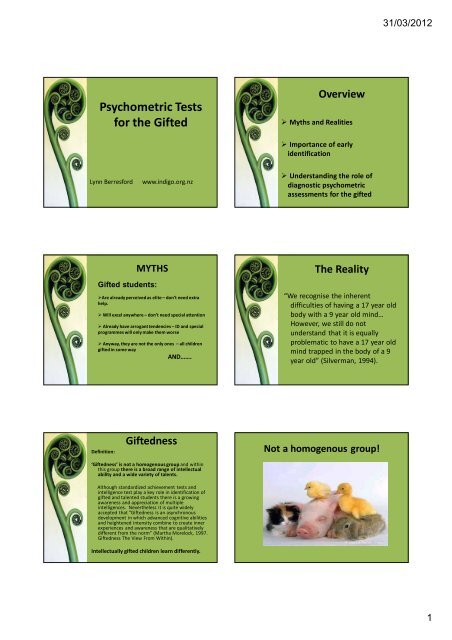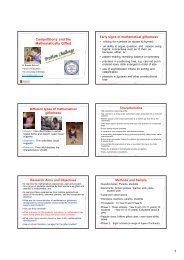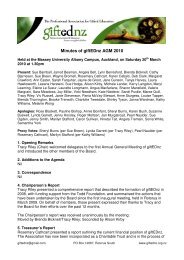Psychometric Tests for the Gifted
Psychometric Tests for the Gifted
Psychometric Tests for the Gifted
You also want an ePaper? Increase the reach of your titles
YUMPU automatically turns print PDFs into web optimized ePapers that Google loves.
31/03/2012<br />
<strong>Psychometric</strong> <strong>Tests</strong><br />
<strong>for</strong> <strong>the</strong> <strong>Gifted</strong><br />
Overview<br />
Myths and Realities<br />
Importance of early<br />
identification<br />
Lynn Berres<strong>for</strong>d<br />
www.indigo.org.nz<br />
Understanding <strong>the</strong> role of<br />
diagnostic psychometric<br />
assessments <strong>for</strong> <strong>the</strong> gifted<br />
MYTHS<br />
<strong>Gifted</strong> students:<br />
Are already perceived as elite – don’t need extra<br />
help.<br />
Will excel anywhere – don’t need special attention<br />
Already have arrogant tendencies – ID and special<br />
programmes will only make <strong>the</strong>m worse<br />
Anyway, <strong>the</strong>y are not <strong>the</strong> only ones – all children<br />
gifted in some way<br />
AND…….<br />
The Reality<br />
“We recognise <strong>the</strong> inherent<br />
difficulties of having a 17 year old<br />
body with a 9 year old mind…<br />
However, we still do not<br />
understand that it is equally<br />
problematic to have a 17 year old<br />
mind trapped in <strong>the</strong> body of a 9<br />
year old” (Silverman, 1994).<br />
Definition:<br />
<strong>Gifted</strong>ness<br />
Not a homogenous group!<br />
‘<strong>Gifted</strong>ness’ is not a homogenous group and within<br />
this group <strong>the</strong>re is a broad range of intellectual<br />
ability and a wide variety of talents.<br />
Although standardized achievement tests and<br />
intelligence test play a key role in identification of<br />
gifted and talented students <strong>the</strong>re is a growing<br />
awareness and appreciation of multiple<br />
intelligences. Never<strong>the</strong>less it is quite widely<br />
accepted that “<strong>Gifted</strong>ness is an asynchronous<br />
development in which advanced cognitive abilities<br />
and heightened intensity combine to create inner<br />
experiences and awareness that are qualitatively<br />
different from <strong>the</strong> norm” (Martha Morelock, 1997.<br />
<strong>Gifted</strong>ness The View From Within).<br />
Intellectually gifted children learn differently.<br />
1
31/03/2012<br />
Reality [continued]<br />
• <strong>Gifted</strong>ness can be observed in<br />
rapid early development<br />
• Parents can be excellent identifiers<br />
of giftedness BUT are not always<br />
listened to and when <strong>the</strong>y fail to<br />
recognise gifts teachers may<br />
overlook <strong>the</strong>m too.<br />
Reality [continued]<br />
2 nd born children are recognised as<br />
gifted much less frequently than<br />
1 st borns.<br />
Asynchrony is often seen in large<br />
discrepancies between specific<br />
learning abilities and may mask<br />
giftedness.<br />
Early Identification is<br />
important<br />
BUT<br />
<strong>Psychometric</strong> Testing<br />
<strong>Psychometric</strong> Testing <strong>for</strong><br />
<strong>the</strong> gifted is not always<br />
intelligently diagnostic<br />
and <strong>the</strong> reported results<br />
not always understood.<br />
2
31/03/2012<br />
BUT<br />
Psychological Assessment Tools are needed<br />
Psychological Assessment Tools<br />
Wechsler Preschool and<br />
Primary Scale of<br />
Intelligence (WPPSI-<br />
III)<br />
Wechsler Intelligence<br />
Scale <strong>for</strong> Children<br />
(WISC-IV)<br />
Stan<strong>for</strong>d Binet<br />
Intelligence Scales -<br />
Fifth Edition<br />
Age range<br />
IQ range<br />
2.6 years to 7.3 years 41 to 155<br />
6.0 years to<br />
16.11years<br />
2.0 years to 89.11<br />
years<br />
40 to 160<br />
40 -160<br />
Stan<strong>for</strong>d Binet LM 2 years to adult 36 to 300+<br />
Woodcock–Johnson III<br />
Standard Test of<br />
Cognition Abilities (WJ-<br />
III)<br />
2 years to 90 + years 40 to 160<br />
Levels of <strong>Gifted</strong>ness<br />
• MG – Moderately <strong>Gifted</strong> (IQ 130 – 145)<br />
2 standard deviations from <strong>the</strong> mean<br />
Language: Wechsler, WJIII & SB<br />
Wechsler Intelligence Scale<br />
<strong>for</strong> Children (WISC-IV)<br />
Range<br />
Very Superior<br />
Superior<br />
IQ range<br />
130 – 160 (top 2%)<br />
120 – 129 (top 9%)<br />
• HG – Highly <strong>Gifted</strong> (IQ 145 – 160)<br />
3 standard deviations from <strong>the</strong> mean<br />
Woodcock Johnson III<br />
Standard Test of Cognition<br />
Abilities (WJIII)<br />
Very Superior<br />
Superior<br />
131 and above<br />
121 to 130<br />
• EG – Extremely <strong>Gifted</strong> (IQ 160 – 180)<br />
4 standard deviations from <strong>the</strong> mean<br />
Stan<strong>for</strong>d Binet Intelligence<br />
Scales - Fifth Edition<br />
Very <strong>Gifted</strong><br />
<strong>Gifted</strong><br />
Superior<br />
145 – 160 (top 0.1%)<br />
130 – 144 (top 2%)<br />
120 – 129 (top 9%)<br />
• PG – Profoundly <strong>Gifted</strong> (IQ 180 +)<br />
5 or more standard deviations from <strong>the</strong> mean<br />
Stan<strong>for</strong>d Binet LM<br />
Very Superior<br />
Superior<br />
160 – 169 (top 0.03%)<br />
150 – 159 (0.2%)<br />
140 – 149 (1.1%)<br />
130 – 139 (3.1%)<br />
120 – 129 (8.2%)<br />
3
31/03/2012<br />
Raven’s Progressive Matrices – most<br />
popular intelligence scale world wide<br />
WISC IV – is used widely and when <strong>the</strong>re are<br />
extreme discrepancies between composite<br />
scores on <strong>the</strong> WISC IV <strong>the</strong> Full Scale IQ score is<br />
NOT <strong>the</strong> best way to describe a student.<br />
WISC IV – GAI [drops WM and PS; emphasises<br />
reasoning ability] can sometimes be acceptable<br />
<strong>for</strong> selection / identification.<br />
Low Scores on Processing Speed and Working<br />
Memory can lower FSIQ.<br />
WISC IV – VCI or PRI may be used<br />
independently <strong>for</strong> culturally diverse, bilingual, 2E<br />
or Visual Spatial Learners.<br />
SB5 – can also use ei<strong>the</strong>r <strong>the</strong> Verbal IQ or Non<br />
Verbal IQ independently to identify gifted<br />
children with different strengths.<br />
More Visual-Spatial content on SB5<br />
Woodcock-Johnson III<br />
Used to Predict:<br />
Achievement in specific curriculum areas<br />
Overall school achievement<br />
Per<strong>for</strong>mance clusters<br />
Screening purposes, but not a comprehensive<br />
measure of intelligence.<br />
Woodcock-Johnson III<br />
Computer Summary graphing results<br />
include:<br />
Raw Score<br />
Grade Equivalent<br />
Age Equivalent<br />
Relative Proficiency Index<br />
Percentile Rank<br />
Easy to Difficult Band<br />
100<br />
90<br />
80<br />
70<br />
60<br />
50<br />
40<br />
30<br />
20<br />
10<br />
0<br />
Stan<strong>for</strong>d Binet - 5th Edition<br />
SUBTEST PERCENTILE SCORES<br />
Non Verbal IQ<br />
Fluid Reasoning<br />
Knowledge<br />
Quantitative Reasoning<br />
Visual Spatial Processing<br />
Working Memory<br />
Verbal IQ<br />
Fluid Reasoning<br />
Knowledge<br />
Quantitative Reasoning<br />
Visual Spatial Processing<br />
Working Memory<br />
100<br />
90<br />
80<br />
70<br />
60<br />
50<br />
40<br />
30<br />
20<br />
10<br />
0<br />
Fluid Reasoning<br />
AREA PERCENTILE SCORES<br />
Knowledge<br />
Quantitative Reasoning<br />
Visual Spatial Processing<br />
Working Memory<br />
4
31/03/2012<br />
100<br />
90<br />
80<br />
Verbal<br />
WPPSI-III Percentile Scores<br />
Per<strong>for</strong>mance Processing General<br />
IQ / INDEX SCORES<br />
Speed Language<br />
WPPSI III PERCENTILE SCORES<br />
100<br />
Verbal Per<strong>for</strong>mance Processing<br />
IQ / INDEX<br />
Speed<br />
SCORES<br />
90<br />
80<br />
Verbal<br />
100<br />
90<br />
80<br />
WISC-IV Percentile Scores<br />
Perceptual Working Processing<br />
IQ / INDEX SCORES<br />
Memory Speed<br />
100<br />
90<br />
70<br />
60<br />
50<br />
40<br />
30<br />
70<br />
60<br />
50<br />
40<br />
Percentile Rank<br />
70<br />
60<br />
50<br />
40<br />
30<br />
Percentile Rank<br />
80<br />
70<br />
60<br />
50<br />
40<br />
20<br />
10<br />
30<br />
20<br />
20<br />
10<br />
0<br />
30<br />
20<br />
0<br />
10<br />
10<br />
0<br />
0<br />
Perceptual Reasoning<br />
Verbal Comprehension<br />
Working Memory<br />
Processing Speed<br />
Full Scale<br />
WISC-IV Percentile Scores - Dyslexic<br />
Verbal<br />
Perceptual<br />
Working<br />
Memory<br />
Processing<br />
Speed<br />
IQ / INDEX SCORES<br />
100<br />
100<br />
90<br />
80<br />
90<br />
70<br />
80<br />
Percentile Rank<br />
60<br />
50<br />
40<br />
30<br />
Percentile Rank<br />
70<br />
60<br />
50<br />
40<br />
20<br />
30<br />
10<br />
0<br />
20<br />
10<br />
0<br />
WISC-IV Percentile Scores - Dysgraphic<br />
Verbal<br />
Perceptual<br />
Working<br />
Memory<br />
Processing<br />
Speed<br />
IQ / INDEX SCORES<br />
100<br />
100<br />
90<br />
90<br />
80<br />
80<br />
70<br />
60<br />
70<br />
50<br />
60<br />
40<br />
50<br />
30<br />
40<br />
20<br />
30<br />
10<br />
20<br />
0<br />
Similarities<br />
Vocabulary<br />
Comprehension<br />
Block Design<br />
Picture Concepts<br />
Matrix Reasoning<br />
Digit Span<br />
Letter-Number Sequence<br />
Coding<br />
Symbol Search<br />
10<br />
0<br />
Perceptual Reasoning<br />
Verbal Comprehension<br />
Working Memory<br />
Processing Speed<br />
Full Scale<br />
5
31/03/2012<br />
WISC-IV Percentile Scores - Dyscalculic<br />
Verbal<br />
Perceptual<br />
Working<br />
Memory<br />
Processing<br />
Speed<br />
IQ / INDEX SCORES<br />
100<br />
90<br />
80<br />
70<br />
60<br />
50<br />
40<br />
30<br />
20<br />
10<br />
0<br />
100<br />
90<br />
80<br />
70<br />
60<br />
50<br />
40<br />
30<br />
20<br />
10<br />
0<br />
WISC-IV Percentile Scores – ADHD<br />
Verbal<br />
Perceptual<br />
Working<br />
Memory<br />
Processing<br />
Speed<br />
IQ / INDEX SCORES<br />
100<br />
90<br />
80<br />
70<br />
60<br />
50<br />
40<br />
30<br />
20<br />
10<br />
0<br />
100<br />
90<br />
80<br />
70<br />
60<br />
50<br />
40<br />
30<br />
20<br />
10<br />
0<br />
WISC-IV Percentile Scores - Autistic<br />
Verbal<br />
Perceptual<br />
Working<br />
Memory<br />
Processing<br />
Speed<br />
IQ / INDEX SCORES<br />
100<br />
90<br />
80<br />
70<br />
60<br />
50<br />
40<br />
30<br />
20<br />
10<br />
0<br />
100<br />
90<br />
80<br />
70<br />
60<br />
50<br />
40<br />
30<br />
20<br />
10<br />
0<br />
6
31/03/2012<br />
Acknowledgements<br />
Many thanks and appreciation to Linda<br />
Kreger Silverman and Rose Blackett who<br />
have worked closely with me on similar<br />
presentations.<br />
7






![Sara Meadows.ppt [Compatibility Mode] - The Professional ...](https://img.yumpu.com/21469333/1/184x260/sara-meadowsppt-compatibility-mode-the-professional-.jpg?quality=85)


